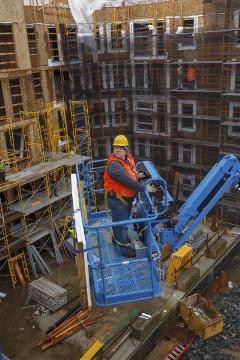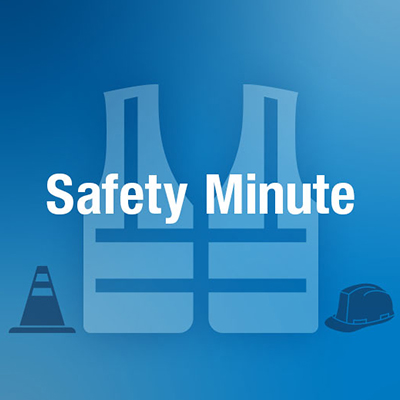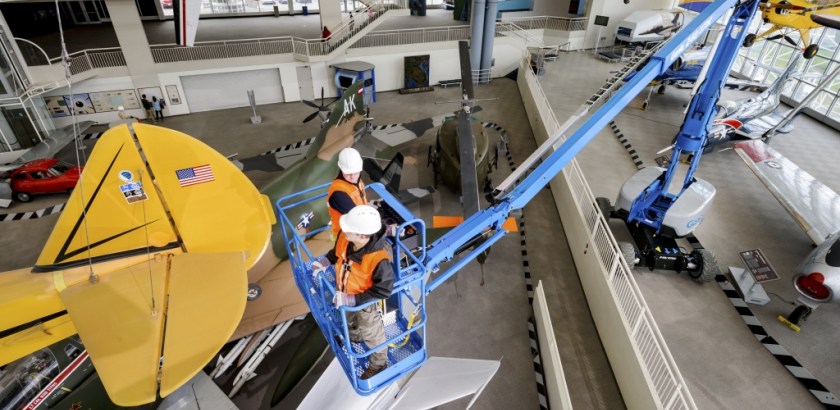Selecting the Best Aerial Lift to Fit Your Jobsite Needs
by Adam Hailey - Director of Global Design Engineering On Dec 6, 2018, 03:00 AM
Subscribe To Aerial Pros
Filter by tags
While every jobsite has its unique challenges and requirements, there are a few key elements that will help you determine the best fit machine for the job. Location, terrain and platform reach need to be considered in order to choose the best aerial lift to best fit your jobsite needs.
Location and terrain
The first thing to consider is the location and terrain. For instance, depending if the project will be completed indoors or outdoors will determine the machine best suited for the job.
 When working indoors, it is vital your lift is able to make it through doorways and around obstacles. Smaller compact lifts are great options to choose when completing work indoors. They offer maneuverability, compact size and can be manually or self-propelled. Also, remember that indoor jobsites may or may not have power available to charge electric machines. Machines equipped with LPG or hybrid power sources offer you the flexibility to work on indoor jobsites without worrying about available charging stations or running out of battery in the middle of the job.
When working indoors, it is vital your lift is able to make it through doorways and around obstacles. Smaller compact lifts are great options to choose when completing work indoors. They offer maneuverability, compact size and can be manually or self-propelled. Also, remember that indoor jobsites may or may not have power available to charge electric machines. Machines equipped with LPG or hybrid power sources offer you the flexibility to work on indoor jobsites without worrying about available charging stations or running out of battery in the middle of the job.
When selecting a machine for outdoors applications, the first consideration is the terrain, or ground conditions: Has the jobsite been improved or is there significant variation in terrain that will require a fully RT capable machine? Is there sufficient space to directly approach the work site or will a larger machine be required to reach up, over or around obstacles? These questions will help you determine the driving and positioning capabilities of the machine to home in on a solution.
Platform reach
Once you determine if you need an aerial lift for indoor and outdoor use, ask yourself, “How will the platform reach the working area?” Taking the platform reach into consideration is a key deciding factor for which lift to use. Direct access vertically could give you access to a range of cost effective scissors. They are compact, maneuverable and highly productive.
You then need to consider the obstacles on the jobsite that the aerial lift will have to work around. The capabilities of either articulated or telescopic booms may be required. The versatile platform positioning power of articulated booms means that they can weave their way into many hard to reach areas, while telescopic booms are notably strong in higher capacity or further reaching applications.
How much working space do you have?
Some obstacles on jobsites, either on the ground or in the air, may preclude the use of certain machines. While scissor lifts will be cost-effective workhorses for compact or high-capacity vertical only access, there are many jobs where these high productivity machines just cannot get to. Getting into these tight work spaces require a narrow chassis such as those found on low-level access lifts, while telescopic boom lifts are great for reaching out over large gaps.
There is always an ideal aerial lift for nearly any job, you just need to consider the use of the machine before choosing the best fit aerial lift.
Related Posts

Chad Hislop - Genie Director of Engineering, Terex AWP
I first found Genie at a Career Fair at the University of Washington when I was looking for an internship.
Continue Reading

Jon Dalberg - Genie Commodity Manager, Terex AWP
I started my career with Genie in 1998. Soon after that, I became the Hydraulics Buyer for Genie® Big Booms in Building #3.
Continue Reading

Genie Safety Minute: Loading an AWP for Transport
Genie Safety Minute is intended to facilitate health and safety discussions on the job site.
Continue Reading


